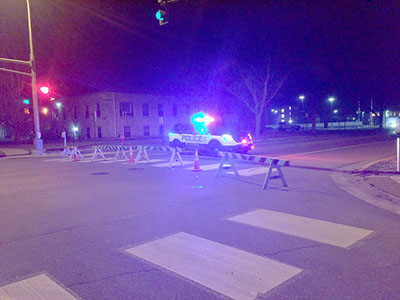No evacuation necessary during domestic dispute standoff
March 23, 2016

Zach Bailey / Winonan
A violent domestic dispute led to multiple police officers, ambulances and even a SWAT team to blockade Sarnia Street from Hamilton Street down to Franklin Avenue on Thursday, March 10, starting around 5 p.m.
While most of the Winona State University students were gone on spring break, the dispute between Lee William Arnold, 32, and his girlfriend began in a vehicle outside the Sugar Loaf Apartments near Winona State University’s East Lake Apartments and lasted for more than eight hours.
According to an all-university email from Assistant Director of Security Scott Bestul, evacuation of the East Lake Apartments was not necessary.
Paul Bostrack, Chief of Police for the City of Winona Police Department, said threats involving a weapon had been made prior to the incident.
“Eventually we were able to make contact with the man, and we did have probable cause to arrest him,” Bostrack said. “During this incident, the man was alone in his apartment, and when the suspect is believed to be armed, we don’t go rushing in. We first try to make contact or see if we can have them come out.”
Procedures are enacted in different ways in cases similar to this situation, especially when it happens near public places, businesses or campus and school buildings.
Bostrack said in this case, no Winona State buildings needed to be evacuated because of the measures taken by officers.
“In this case, there were enough officers on the scene, the place was fully secured, and we knew nothing would go beyond that building,” Bostrack said. “In situations like this, we first let the people nearest the situation know of what’s going on and evacuate if needed. During this event, the situation was contained enough to where we didn’t have to go out to evacuate the immediate area.”
Authorities then continue to notify people in the nearest buildings, cautioning them to stay away from windows and out of sight.
When it comes to drawing the line between evacuating close buildings or not, Bostrack said it depends on the circumstance, such as whether there are weapons possibly involved, if the buildings are in a direct line of sight of the suspect and if the immediate scene is contained or not.
Bostrack said, “There really is no set difference, because there are so many factors that can go into it.”






































































